3/19/16-3/27/16
Happy Easter! He is risen! I just returned from a week of vacationing aka traveling during Spain’s Semana Santa or Holy Week leading up to Easter. (More to share about my vacationing in Blog post Part 2)
Being that Spain is a very Catholic country, this week is extremely significant and full of events. Beginning on Palm Sunday Spaniards young and old process through the streets at nearly every hour of the day. These processions are absolutely gorgeous; a true spectacle. Each day has a different theme accompanied by specific music and colors. The processions consist of vibrant brass bands (with occasional reed instruments), men and women called narzarenos wearing capirotes and holding candles, young children also carrying candles, women dressed in mantillas, and enormous floats called pasos.
The music. The pounding drums can be heard throughout 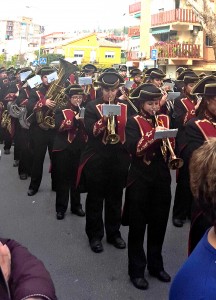 all of the neighborhood. They also set the pace for everyone in the procession, swaying left right left right in a slow and deliberate march. The bands consist of mainly brass instruments and produce absolutely powerful walls of sound, some ominous songs and others cheerful fanfares. The trumpet section is perhaps most impressive as it consists of a mix of standard valve trumpets and old traditional horns without valves. My goodness do they hit the high notes though! The pattern of the songs typically begins with a loud statement followed by the final big chord that decrescendos into a soft drone as a solo trumpet dances along this line. When the solo ends the band swells again and the drummers beat fiercely in a final declaration of either pride or sorrow depending upon which float the band is following. Band members wear gorgeous, ornate outfits as seen here.
all of the neighborhood. They also set the pace for everyone in the procession, swaying left right left right in a slow and deliberate march. The bands consist of mainly brass instruments and produce absolutely powerful walls of sound, some ominous songs and others cheerful fanfares. The trumpet section is perhaps most impressive as it consists of a mix of standard valve trumpets and old traditional horns without valves. My goodness do they hit the high notes though! The pattern of the songs typically begins with a loud statement followed by the final big chord that decrescendos into a soft drone as a solo trumpet dances along this line. When the solo ends the band swells again and the drummers beat fiercely in a final declaration of either pride or sorrow depending upon which float the band is following. Band members wear gorgeous, ornate outfits as seen here.
Here is a much needed sound byte of the impressive sounds of Semana Santa!
The narzarenos are individuals considered to be showing penitence; they are 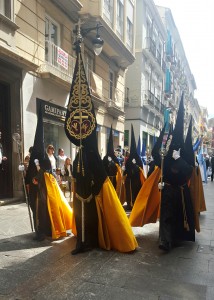 dressed in very distinct robes with capirotes, or large pointed caps. I want to be very clear: this is an ancient tradition dating back to Medieval times, so these outfits definitely look like KKK garb, but are definitely not. Every American student was uncomfortable viewing the outfits as they look so much like the horrible racist group, but it is a distinct element of the Catholic tradition. So please, do not be alarmed. The narzarenos carry large candles or banners. Interestingly, each time a procession would stop to wait for the floats to turn a corner etc. kids from the sides of the streets would flock to the candle bearers. The kids had balls of wax and would collect the wax drippings as the procession members waited to continue walking. By the end of the week many kids had rather impressive collections of wax.
dressed in very distinct robes with capirotes, or large pointed caps. I want to be very clear: this is an ancient tradition dating back to Medieval times, so these outfits definitely look like KKK garb, but are definitely not. Every American student was uncomfortable viewing the outfits as they look so much like the horrible racist group, but it is a distinct element of the Catholic tradition. So please, do not be alarmed. The narzarenos carry large candles or banners. Interestingly, each time a procession would stop to wait for the floats to turn a corner etc. kids from the sides of the streets would flock to the candle bearers. The kids had balls of wax and would collect the wax drippings as the procession members waited to continue walking. By the end of the week many kids had rather impressive collections of wax.

Kids were all throughout the processions as well! As seen above, a young girl is  sharing her candle wax with another. Other kids carried incense, small banners, and were even official candle lighters.
sharing her candle wax with another. Other kids carried incense, small banners, and were even official candle lighters.
If anyone’s candle went out, he or she was in charge of relighting it. It was absolutely precious watching one particular girl try and try to relight a very stubborn can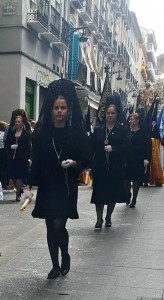 dle. She did succeed. Young girls and women also dressed in traditional mantillas: an all-black dress with a black suit jacket, and a gorgeous headpiece that held a large lace veil.
dle. She did succeed. Young girls and women also dressed in traditional mantillas: an all-black dress with a black suit jacket, and a gorgeous headpiece that held a large lace veil.
The highlight of each procession is the paso or grandiose float. There are usually two, one depicting the Virgin Mary and the other of Christ. The Virgin Mary is usually white and silver followed by women dressed in mantillas with white veils. Christ’s paso is red and gold and followed by the black mantilla veils. Some of the pasos have been around since the 1600s and still look magnificent. The floats are carried from underneath, meaning that rows of little white shoes can be seen carrying them along.
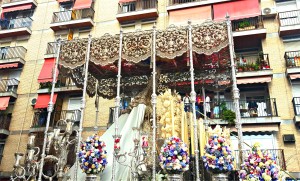
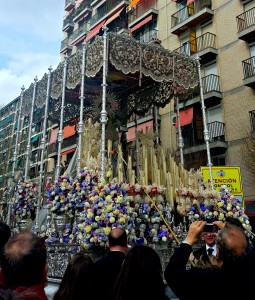
 All in all it was a marvelous sight to behold. I must confess though that for me it was an amazing cultural experience; however, I was painfully aware that for the Spaniards, this was a deeply religious, sacred event. I wished I knew more of the significance of what I was witnessing and could have taken part not just in the viewing but in the spirituality of the processions. I am glad I had the experience and I am glad to have had the chance to recognize more cultural barriers so that I may continue to grow and become more respectful and aware.
All in all it was a marvelous sight to behold. I must confess though that for me it was an amazing cultural experience; however, I was painfully aware that for the Spaniards, this was a deeply religious, sacred event. I wished I knew more of the significance of what I was witnessing and could have taken part not just in the viewing but in the spirituality of the processions. I am glad I had the experience and I am glad to have had the chance to recognize more cultural barriers so that I may continue to grow and become more respectful and aware.
(Semana Santa Part 2 will come next since this week was so full that I could not contain it all to one blog. Micro bio to come then!)

